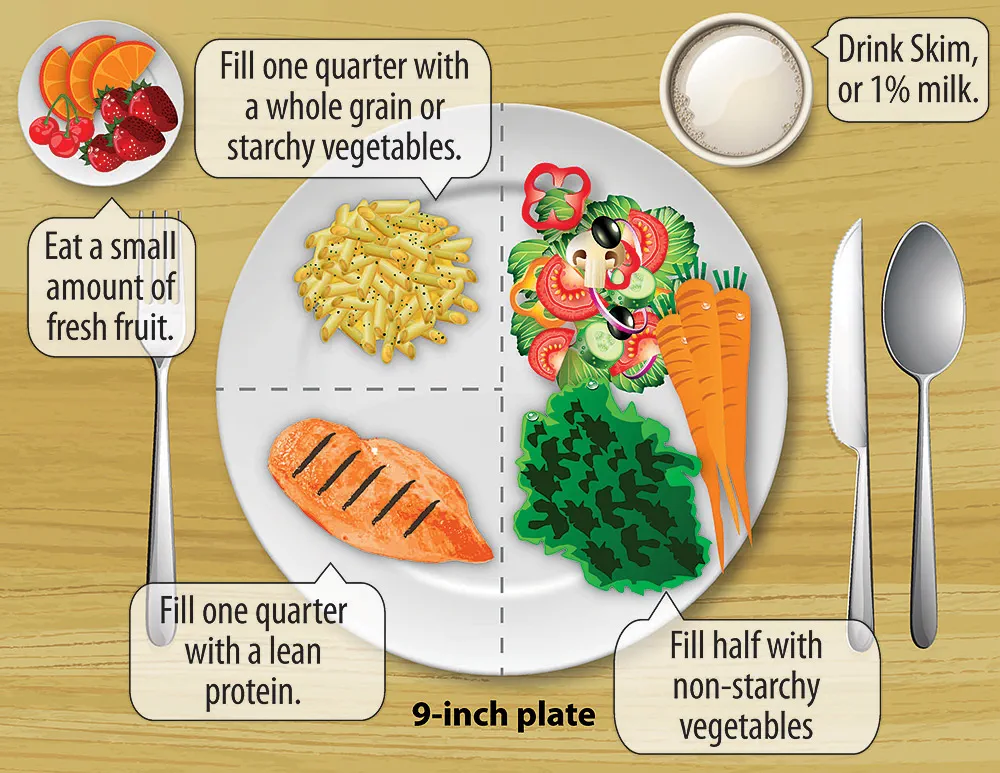Diabetic Diet and Menu: A Complete Guide to Healthy Eating for Blood Sugar Control
Managing diabetes begins with what’s on your plate. A well-balanced diabetic diet and menu plan can make a significant difference in controlling blood sugar levels, preventing complications, and promoting overall health. Whether you’ve just been diagnosed with diabetes or you’re looking to improve your existing dietary habits, this comprehensive guide will help you understand what to eat, what to avoid, and how to create a sustainable diabetic menu that fits your lifestyle.
A diabetic diet doesn’t have to be restrictive or boring. In fact, it can be diverse, flavorful, and highly nutritious. By focusing on whole foods, proper portion control, and the right balance of carbohydrates, protein, and healthy fats, you can enjoy meals while managing your blood sugar effectively.
What Is a Diabetic Diet?
A diabetic diet is a nutritional plan that’s designed to help individuals with diabetes control their blood sugar (glucose) levels. The goal is to eat a variety of healthy foods in moderate amounts at regular meal times. A good diabetic diet includes:
- Non-starchy vegetables
- Lean proteins
- Whole grains
- Healthy fats
- Controlled portions of carbohydrates
The primary focus is on managing carbohydrate intake because carbohydrates directly impact blood glucose levels. The right choices of carbohydrates can help keep blood sugar levels within the target range.
Core Principles of a Diabetic Diet and Menu
The foundation of any effective diabetic diet and menu includes three key components: balanced nutrition, portion control, and consistency.
1. Balanced Nutrition
A diabetic-friendly plate should be composed of:
- 50% non-starchy vegetables like spinach, broccoli, and bell peppers
- 25% lean protein such as chicken, tofu, or fish
- 25% whole grains or complex carbohydrates like quinoa, brown rice, or lentils
This balance helps slow glucose absorption and maintains steady blood sugar throughout the day.
2. Portion Control
Even healthy foods can spike blood sugar if eaten in excess. Using measuring cups, food scales, or the plate method can help keep portions in check.
3. Consistency in Meals
Eating meals and snacks at consistent times each day helps regulate insulin levels and reduces blood sugar fluctuations. Skipping meals can lead to dips and spikes that are harmful over time.
Best Foods to Include in a Diabetic Diet
Creating a diabetic diet and menu starts with choosing the right foods. Here are food groups that should be staples in your diet:
Non-Starchy Vegetables
These are low in carbs and high in fiber, making them ideal for blood sugar control:
- Spinach
- Kale
- Broccoli
- Asparagus
- Zucchini
- Cauliflower
Lean Proteins
Proteins do not raise blood sugar and help with satiety:
- Chicken breast
- Fish (especially fatty fish like salmon)
- Eggs
- Tofu
- Greek yogurt
- Legumes (lentils, chickpeas)
Whole Grains and Complex Carbs
These are digested more slowly, resulting in a gradual rise in blood sugar:
- Quinoa
- Brown rice
- Oats
- Barley
- Whole wheat bread
- Sweet potatoes
Healthy Fats
Healthy fats support heart health and improve insulin sensitivity:
- Avocados
- Nuts and seeds
- Olive oil
- Fatty fish
- Nut butters (without added sugar)
Low-Glycemic Fruits
Fruits should be eaten in moderation but are a good source of vitamins and fiber:
- Berries (blueberries, strawberries)
- Apples
- Pears
- Peaches
- Cherries
Foods to Limit or Avoid
While no food is completely off-limits, the following should be limited or avoided to keep blood sugar stable:
- Sugary drinks (soda, sweetened tea)
- White bread and pasta
- Baked goods and desserts
- Processed snacks (chips, crackers)
- Fried foods
- High-fat dairy products
- Alcohol (in excess)
Avoiding refined carbohydrates and added sugars is crucial in preventing blood sugar spikes.
Sample Diabetic Menu Plan
Here’s a full-day sample diabetic menu that includes three main meals and two snacks:
Breakfast
- Scrambled eggs with spinach and tomatoes
- One slice of whole grain toast
- Half a grapefruit or a handful of blueberries
- Black coffee or herbal tea
Morning Snack
- A small handful of almonds
- One boiled egg
Lunch
- Grilled chicken breast
- Mixed greens salad with cucumber, cherry tomatoes, and olive oil vinaigrette
- Half cup of quinoa or brown rice
Afternoon Snack
- Low-fat Greek yogurt (unsweetened)
- A few slices of apple or pear
Dinner
- Baked salmon with lemon and herbs
- Steamed broccoli and cauliflower
- Sweet potato mash (small portion)
Evening Option (if needed)
- Chamomile tea
- One rice cake with peanut butter
This menu is balanced with complex carbs, lean protein, and healthy fats—ideal for blood sugar control.
Importance of the Glycemic Index
The Glycemic Index (GI) is a tool that helps diabetics choose the right carbohydrates. It measures how quickly a food raises blood sugar.
- Low GI (55 or less): lentils, oats, sweet potatoes, most fruits
- Medium GI (56–69): brown rice, couscous
- High GI (70+): white bread, rice cakes, sugary cereals
Sticking to low and moderate GI foods can help avoid spikes in glucose levels.
Creating Your Personalized Diabetic Menu
Everyone’s body responds differently to food. Working with a registered dietitian can help you personalize your diabetic diet and menu based on:
- Age
- Weight goals
- Activity level
- Blood sugar levels
- Medication
Some may follow low-carb diets, while others may need moderate carb intake with higher fiber. The key is monitoring how your blood sugar responds and adjusting accordingly.
Meal Planning Tips for Diabetics
- Plan meals in advance to avoid impulsive eating
- Read nutrition labels for carb and sugar content
- Prep ingredients in bulk to make cooking easier
- Keep healthy snacks on hand to avoid processed options
- Choose whole, minimally processed foods whenever possible
Consistency in both meal timing and nutritional content is critical in long-term diabetic control.
Dining Out While Following a Diabetic Diet
Staying on track doesn’t mean you can’t enjoy a meal out. Some smart tips include:
- Choose grilled over fried
- Ask for dressings or sauces on the side
- Opt for whole grain sides when available
- Control portions—consider sharing dishes or saving half for later
- Skip sugary drinks in favor of water or unsweetened tea
Communicating dietary needs to the restaurant staff can also help ensure a better experience.
Monitoring Blood Sugar with Your Diet
Diet plays a significant role in how blood sugar behaves. It’s important to:
- Monitor your blood sugar before and after meals
- Note which foods cause spikes or dips
- Keep a food and glucose log to identify trends
Over time, you’ll develop a better understanding of what your body tolerates well and what to minimize.
Common Mistakes in Diabetic Meal Planning
- Skipping meals or snacks
- Drinking “diet” sodas with hidden sugars
- Relying on packaged “diabetic-friendly” products
- Overeating even healthy foods
- Not accounting for hidden sugars in condiments or sauces
Awareness and education go a long way in building effective eating habits.
The Role of Hydration and Physical Activity
Diet alone isn’t enough. Staying hydrated and staying active are essential for managing diabetes.
- Aim for at least 8 glasses of water a day
- Limit caffeinated or sugary beverages
- Engage in moderate physical activity for at least 30 minutes a day, 5 days a week
Exercise helps improve insulin sensitivity and supports weight management.
Final Thoughts
A carefully structured diabetic diet and menu is one of the most powerful tools for managing blood sugar levels, preventing complications, and leading a healthy life. The best approach is not about deprivation but about smart choices, balanced meals, and consistency. When you nourish your body with the right foods, you’ll feel better, have more energy, and maintain better control over your diabetes.
Take the time to understand your nutritional needs, experiment with recipes, and enjoy the process of building a lifestyle that supports your health. With the right planning and support, living with diabetes can be both manageable and rewarding.
FAQs
1. What is the best diet for diabetics?
A balanced diet rich in non-starchy vegetables, lean proteins, whole grains, and healthy fats is best for diabetics. Low-glycemic foods help manage blood sugar effectively.
2. How many meals should a diabetic eat per day?
Most diabetics benefit from eating three balanced meals and 1–2 healthy snacks per day to maintain stable blood sugar levels.
3. Can diabetics eat fruit?
Yes, diabetics can eat fruit in moderation. Low-GI fruits like berries, apples, and pears are better choices.
4. Is a low-carb diet safe for diabetics?
Yes, low-carb diets can be effective for blood sugar control, but they should be followed under medical supervision, especially if you take insulin.
5. Can diabetics eat bread or pasta?
Whole grain bread and pasta can be included in a diabetic diet in moderation. Portion size and fiber content are key considerations.
6. What foods should diabetics avoid completely?
Diabetics should avoid sugary drinks, refined carbs, processed snacks, and high-fat fried foods. These can cause blood sugar spikes and increase health risks.
7. How much sugar can a diabetic eat per day?
While natural sugars from fruits can be included in moderation, added sugars should be limited to less than 10% of daily calorie intake, according to guidelines.
8. Are cheat meals okay in a diabetic diet?
Occasional indulgences are okay if planned carefully and monitored. It’s important not to let cheat meals derail consistent habits.
9. Can I follow a vegetarian or vegan diabetic menu?
Yes, plant-based diets can be excellent for diabetics. Focus on legumes, tofu, whole grains, and vegetables while monitoring carbs and portions.
10. How do I start a diabetic diet if I’m newly diagnosed?
Start by focusing on whole foods, reducing sugar and refined carbs, eating balanced meals, and tracking your blood glucose. Working with a dietitian can provide personalized guidance.






